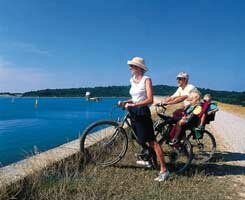You don't have to be super-fit to enjoy cycling, and it's good for you!
When looking to lose weight, diets rarely work long-term, regular exercise always does. Any type of regular exercise is of benefit, but cycling is particularly good because fewer injuries occur as a result of it.
Cycling is also a great calorie user which has various benefits.
According to the British Heart Foundation, cycling at least 20 miles per week reduces the risk of coronary heart disease to less than half that for non-cyclists. Cycling at a gentle 12 mph on a flat road uses 450 kcal per hour. It also makes you feel younger and reduces stress. It is also claimed that cycling raises the speed of your metabolism for hours afterwards, so your body continues to burn calories even after exercise. 
Cycling is mainly an aerobic activity (except when going uphill). This is beneficial to the lungs which expand to push as much oxygen into the body as possible and the heart which beats faster to transport this oxygen around your body. A strong heart and powerful lungs form the basis of general fitness.
Even if you cycle only a few miles per day, your muscles will gain the benefit, usually becoming trimmer and more toned. The main muscles you use when cycling are the upper thigh muscles, backside, and calf muscles.
Exercising releases what are known as endorphins into your blood - these create a feeling of contentment and happiness, therefore helping to reduce stress. Naturally, if you cycle in pleasant suroundings - your contentment level will be even greate